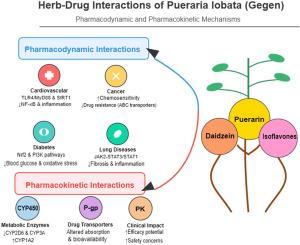Herb-drug interactions involving pueraria lobata and its bioactive constituents: A comprehensive review
Pharmacological Research - Modern Chinese Medicine
Pub Date : 2025-09-25
DOI:10.1016/j.prmcm.2025.100696
引用次数: 0
Abstract
INTRODUCTION
Pueraria lobata (PL) is a traditional Chinese medicinal herb that is rich in isoflavonoids, such as puerarin and daidzein. It is widely used to treat cardiovascular, metabolic and oncological disorders. As PL is increasingly being co-administered with conventional drugs, herb–drug interactions (HDI) have emerged as a significant clinical concern. A comprehensive synthesis of the current evidence base is required to clarify the pharmacodynamic and pharmacokinetic profiles of PL-related interactions, as well as their implications for clinical practice.
METHODS
We conducted a comprehensive review of experimental and clinical studies on HDI involving PL and its bioactive constituents. Literature was retrieved from PubMed, CNKI, and Google Scholar up to April 2024. Studies were included if they reported on the pharmacodynamic or pharmacokinetic interactions between PL (or its constituents) and therapeutic drugs. Twenty-three studies met the eligibility criteria: Twelve addressed pharmacodynamic interactions and eleven addressed pharmacokinetic interactions.
RESULTS
In terms of pharmacodynamics, PL exhibited both synergistic and antagonistic effects. Synergistic outcomes included enhanced efficacy in terms of cardiovascular protection, osteoporosis prevention, glycaemic control and chemosensitisation in cancer therapy. Conversely, adverse outcomes were observed, including attenuation of the antiplatelet effect when combined with warfarin or dual antiplatelet therapy and increased mortality when combined with methotrexate in animal models. In terms of pharmacokinetics, puerarin and other constituents were found to modulate cytochrome P450 enzymes and transporters. The effects included inhibiting CYP2D6, suppressing CYP3A, inducing CYP1A2 and altering P-glycoprotein activity. These mechanisms contribute to variable drug metabolism and bioavailability across co-administered agents.
DISCUSSION
Evidence suggests that PL can have beneficial or harmful effects on HDI, depending on the therapeutic context. However, the available data is limited and is largely derived from preclinical models. There is a lack of rigorous clinical trials and the roles of minor constituents remain under-explored. Research gaps include a lack of data on high-risk populations and an incomplete understanding of the mechanisms of pharmacodynamic interactions. To ensure the rational and safe integration of PL into modern medical practice, future work should prioritise translational studies and broaden the focus beyond puerarin to establish safety profiles.

葛根及其生物活性成分的药物相互作用综述
葛根(pueraria lobata, PL)是一种富含葛根素、大豆苷元等异黄酮类化合物的传统中药。它被广泛用于治疗心血管、代谢和肿瘤疾病。随着PL越来越多地与常规药物联合使用,草药-药物相互作用(HDI)已成为一个重要的临床问题。需要对目前的证据基础进行全面的综合,以阐明pl相关相互作用的药效学和药代动力学特征,以及它们对临床实践的影响。方法全面回顾了与白藜芦醇及其生物活性成分有关的HDI的实验和临床研究。文献检索自PubMed、CNKI和b谷歌Scholar,截止到2024年4月。如果研究报告了PL(或其成分)与治疗药物之间的药效学或药代动力学相互作用,则纳入研究。23项研究符合入选标准:12项研究涉及药效学相互作用,11项研究涉及药代动力学相互作用。结果在药效学方面,丙二醇具有增效和拮抗作用。协同结果包括在心血管保护、骨质疏松预防、血糖控制和癌症化疗增敏方面的疗效增强。相反,观察到不良结果,包括在动物模型中与华法林或双重抗血小板治疗联合使用时抗血小板作用减弱,与甲氨蝶呤联合使用时死亡率增加。在药代动力学方面,葛根素和其他成分可以调节细胞色素P450酶和转运蛋白。其作用包括抑制CYP2D6,抑制CYP3A,诱导CYP1A2,改变p糖蛋白活性。这些机制有助于不同的药物代谢和生物利用度在共同给药的药物。有证据表明,PL对HDI有有益或有害的影响,这取决于治疗环境。然而,可用的数据是有限的,并且主要来自临床前模型。缺乏严格的临床试验,次要成分的作用仍未得到充分探索。研究空白包括缺乏关于高危人群的数据和对药效学相互作用机制的不完全理解。为了确保将葛根素合理、安全地纳入现代医疗实践,未来的工作应优先考虑转化研究,并将重点扩大到葛根素以外,以建立安全性概况。
本文章由计算机程序翻译,如有差异,请以英文原文为准。
求助全文
约1分钟内获得全文
求助全文

 求助内容:
求助内容: 应助结果提醒方式:
应助结果提醒方式:


